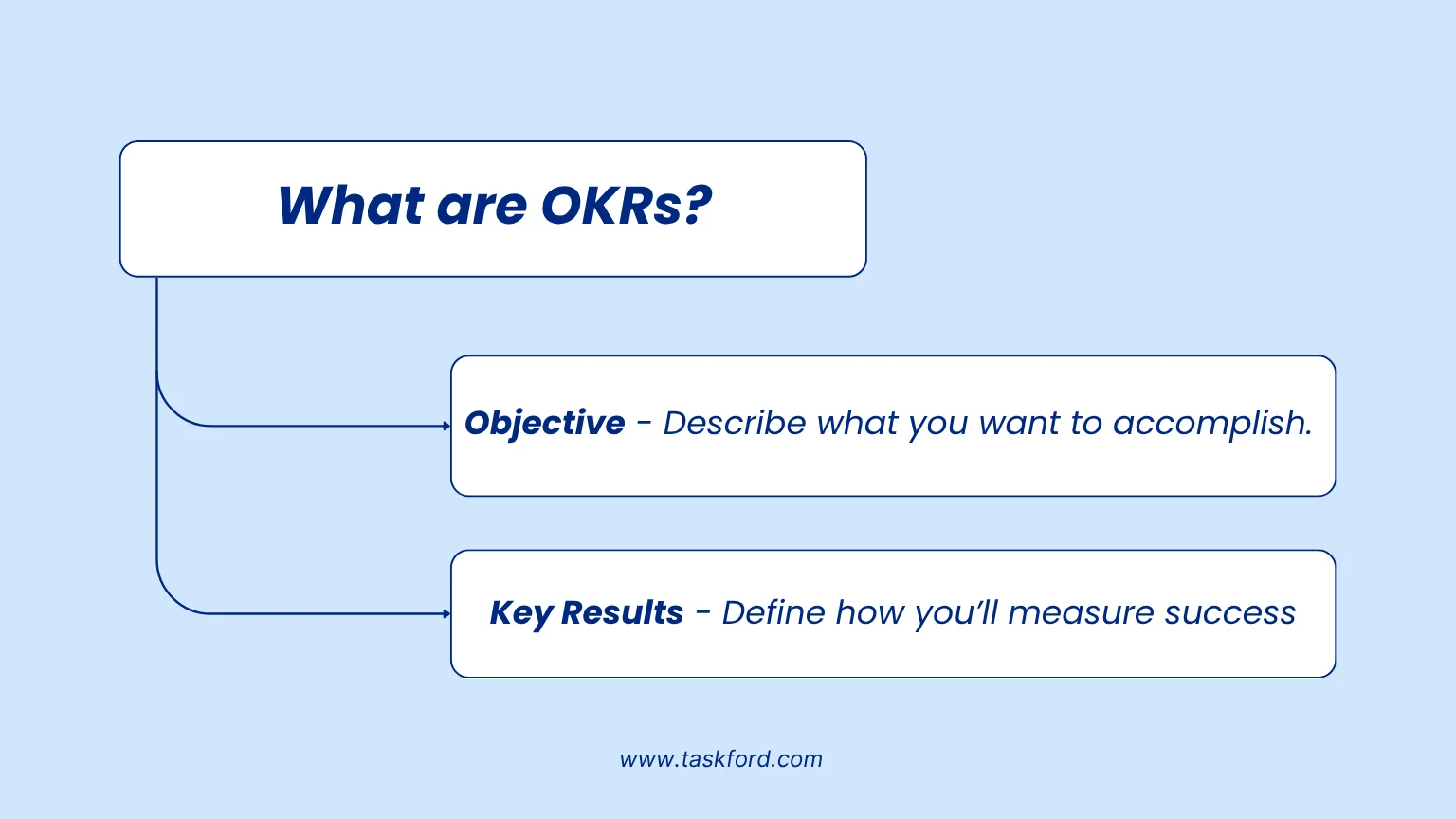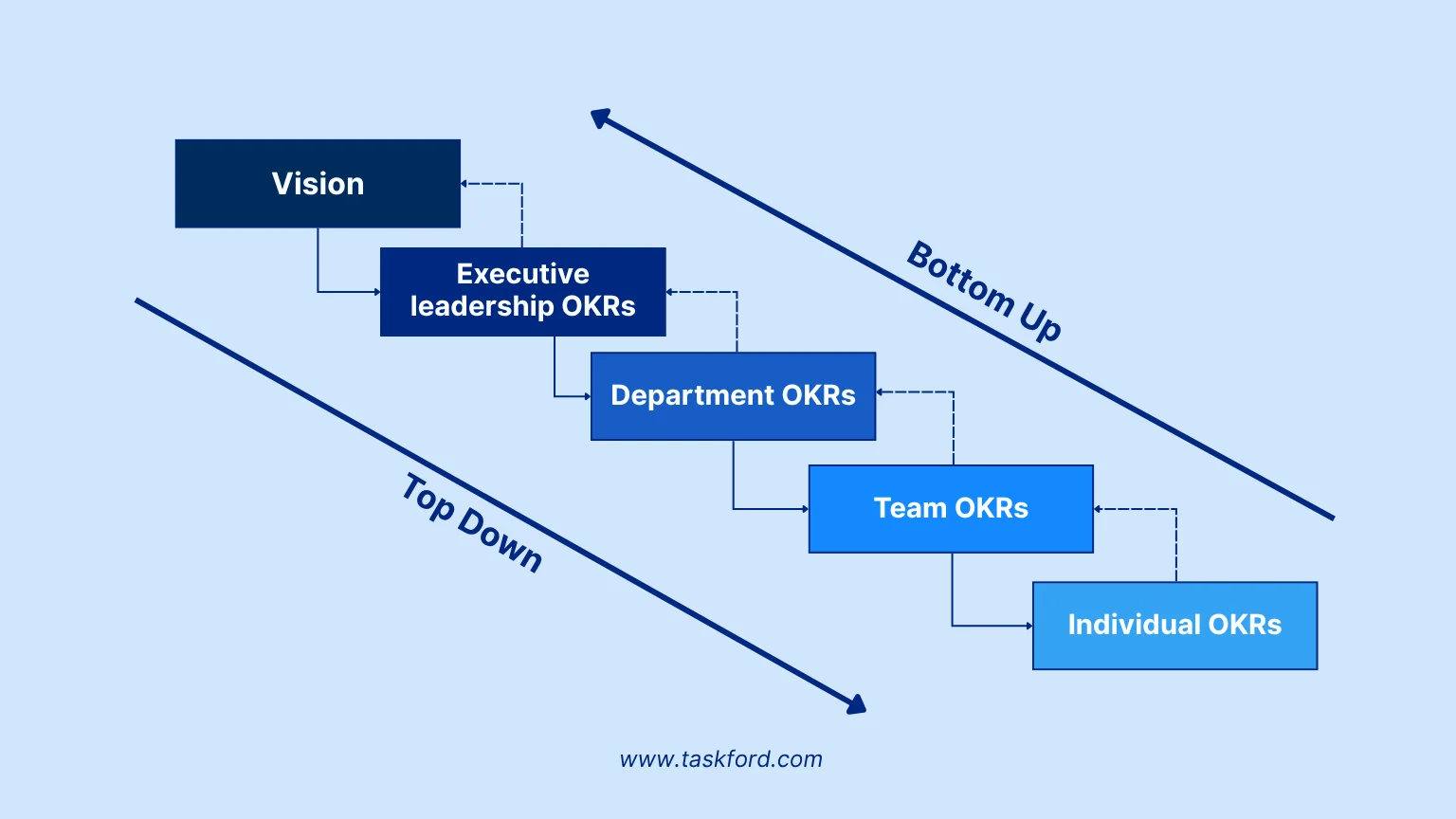What Is OKR in Project Management? A Must-have Guide for Project Teams
Learn what OKR in project management means and how clear Objectives and Key Results help teams stay aligned and connect strategy to real project outcomes.
When teams talk about working with more clarity and focus, OKRs almost always enter the conversation. But if you’re managing projects day-to-day, you might still wonder: What is OKR in project management, and why do teams rely on it so much?
OKRs — short for Objectives and Key Results — provide teams with a straightforward way to define what they want to achieve and how they’ll measure progress. Instead of getting stuck in long task lists or chasing shifting priorities, OKRs help project teams stay aligned on the outcomes that actually matter.
In this guide, we’ll break down what OKRs are and how they work in real project environments. Whether your team is planning a new initiative or trying to stay on track during execution, this must-have guide will help you confidently connect strategic goals to everyday project work.
What are OKRs?
OKRs, which stand for Objectives and Key Results, are a simple framework that helps teams set clear goals and measure progress in a meaningful way. Instead of tracking every task or output, OKRs encourage teams to focus on the outcomes that truly move the project forward.

A Quick History of OKRs
The OKR approach started in the 1970s with Andy Grove, former CEO of Intel. He introduced OKRs to help teams stay aligned during periods of rapid change.
John Doerr later brought the method to Google in the early 2000s, where it became a core part of how the company set goals while scaling quickly. Since then, OKRs have been widely adopted across all types of teams, from startups to large enterprises.
The Objective (O)
The Objective describes what you want to accomplish. It should be clear, meaningful, and easy for the team to understand. A good Objective sets direction without listing tasks.
A strong Objective is:
- Direction-setting: It clearly defines the intended outcome
- Inspirational: It motivates the team to aim for something valuable
- Short and simple: One sentence is enough
Example: Improve our project delivery experience for clients.
The Key Results (KR)
Key Results define how you’ll measure success. They turn the Objective into something trackable and concrete. KRs are measurable outcomes — not tasks.
Strong Key Results are:
- Measurable (quantitative whenever possible)
- Time-bound
- Outcome-focused
- Realistic but meaningful
Example:
- Reduce project delivery time from 30 days to 20 days
- Improve client satisfaction score from 7.5 to 9
- Increase on-time deliverables from 70% to 90%
Together, the Objective and Key Results give teams a clear direction and a practical way to gauge progress — without micromanaging the work.
What is OKR in Project Management?
In project management, OKRs help teams turn high-level goals into clear, measurable outcomes. While traditional project plans focus on tasks, timelines, and project deliverables, OKRs focus on impact — what the team is ultimately trying to achieve.
An OKR in project management answers two simple questions:
Where do we want this project or initiative to go? (Objective) How will we know we’re moving in the right direction? (Key Results)
This approach helps project teams avoid getting stuck in busywork or reacting to shifting priorities. Instead, OKRs give the team a shared direction that stays consistent throughout planning, execution, and delivery.
When used well, OKRs can:
- Keep cross-functional teams aligned
- Connect strategic goals to everyday project work
- Clarify what “success” looks like
- Support better decision-making when priorities compete
In short, OKRs help project teams stay focused on outcomes rather than just completing tasks — making them a useful guide throughout the entire project lifecycle.
Why Project Teams Use OKRs
Project teams work in fast-moving environments where priorities can shift quickly. OKRs help create clarity by highlighting the outcomes that matter most, so teams don’t get lost in long task lists or competing demands.
By setting clear Objectives and measurable Key Results, teams gain a shared direction that’s easy for everyone to understand, especially in cross-functional projects. This alignment makes collaboration smoother and reduces confusion about what the team is working toward.
OKRs also support better prioritization. Instead of spreading effort across many small tasks, teams focus on a few key results that drive real progress. Because these results are measurable, it’s easier to see what’s on track, what needs attention, and when plans should be adjusted.
Most importantly, OKRs encourage outcome-driven thinking. They shift the conversation from “What should we do next?” to “What impact are we trying to create?” Helping teams stay aligned and deliver more meaningful results.
How OKRs Fit Into the Project Lifecycle
OKRs support every stage of the project lifecycle by giving teams a consistent sense of direction. Here’s how they fit in:

1. Project Initiation: Defining Purpose and Direction
During initiation, OKRs help teams translate broad ideas into a clear purpose. They answer questions like: “What impact are we aiming for?”, “Why does this project matter?” Setting early Objectives gives the team a shared understanding of success before any detailed planning begins.
2. Project Planning: Turning Outcomes Into Roadmaps
Once the direction is set, OKRs become a guide for project planning. They help teams prioritize work based on what will drive the Key Results, not just what feels urgent. This ensures that project milestones, timelines, and resource allocations directly support the desired outcomes.
3. Project Execution: Staying Focused and Adaptable
As the team moves into execution, OKRs serve as a reference point. Regular check-ins help the team see what’s on track, what needs attention, and where adjustments are needed.
4. Project Monitoring & Control: Measure Impact, Not Just Activity
OKRs offer measurable indicators for assessing performance throughout the project. Instead of tracking tasks alone, teams evaluate whether actions are moving the Key Results forward.
5. Project Closure: Measuring Impact and Learning
At the end of the cycle, OKRs make it easier to assess whether the team achieved the desired outcomes. The insights gained feed into future planning and continuous improvement.
How to Set up OKRs: From Strategic Vision to Project Execution
Setting up OKRs is about linking the organization’s big-picture goals to the work teams that deliver every day. When the flow is clear, everyone understands both the why and the how behind their priorities.

Step 1: Start with the Strategic Vision
Every OKR cycle begins with the organization’s vision and long-term strategy. This is where leadership defines the “why” — the outcomes the company wants to achieve and the direction it’s moving toward. These high-level goals become the foundation for all OKRs below.
Step 2: Translate Strategy Into Company-Level OKRs
Company OKRs turn the strategic vision into a small set of clear, measurable outcomes. These represent the highest priorities for the organization for the quarter or year. They set the tone, align focus, and communicate what truly matters across departments.
Step 3: Define Department OKRs That Interpret the Impact
With company-level OKRs in place, each department translates them into outcomes they can directly influence. This clarifies how functions like Product, Marketing, or Operations contribute to the broader strategy and ensures teams move in the same direction.
Step 4: Develop Team OKRs for Tactical Execution
Teams then turn departmental goals into actionable, short-term OKRs. These reflect what the team can realistically deliver within a cycle and help guide daily priorities, resource use, and decision-making.
Step 5: Connect OKRs to Projects and Tasks
OKRs describe outcomes, but projects and tasks are how those outcomes happen. Once team OKRs are set, project managers map them to scopes, milestones, sprints, and daily work — making sure every action supports the intended results.
Step 6: Align the Team and Confirm Ownership
Clear ownership keeps OKRs focused. Each Objective and Key Result should have defined owners, contributors, and a tracking process. Sharing this openly helps teams stay aligned and reduces confusion later.
Step 7: Review Progress Regularly
Regular check-ins keep OKRs relevant. By reviewing progress weekly or bi-weekly, teams can identify blockers early, adjust priorities as needed, and stay connected to their goals throughout the cycle.
Examples of OKRs for Project Teams
Seeing OKRs in action makes it easier to understand how they guide real project work. Here are a few practical examples across different types of teams. Each one shows how an Objective sets direction while Key Results define measurable progress.
Example 1: IT / Development Team
- Context: The team struggled with unstable releases and frequent hotfixes, causing delays and customer frustration.
- Objective: Improve the reliability and quality of our upcoming product release.
- Key Results:
- Reduce critical and high-severity bugs reported after release from 15 to 5
- Increase automated test coverage from 45% to 70% to prevent regressions
- Improve deployment success rate from 85% to 98% with fewer rollback events
Example 2: Marketing Project Team
- Context: The team plans a new product launch, but past campaigns lacked strong engagement and lead quality.
- Objective: Launch a high-performing marketing campaign that boosts engagement and attracts qualified leads.
- Key Results:
- Increase campaign landing page traffic by 20% compared to the previous launch
- Improve email CTR (click-through rate) from 3% to 6%
- Generate 200 marketing-qualified leads (MQLs) from campaign content
- Achieve a 10% conversion rate on the signup CTA
Example 3: Operations / Process Improvement Team
- Context: Projects frequently face delays due to unclear workflows and slow approvals across departments.
- Objective: Streamline internal processes to reduce project turnaround time.
- Key Results:
- Reduce approval cycle time from 5 days to 2 days
- Decrease handoff delays between teams by 30%
- Increase the on-time task completion rate from 70% to 90%
- Implement a standardized workflow adopted by 100% of project teams
Conclusion
Understanding what OKR in project management really means can make a big difference in how teams plan, collaborate, and deliver results. OKRs give project teams a clear way to connect strategic goals with everyday execution, making it easier to stay focused on the outcomes that matter most. By aligning company, department, and team-level objectives — and supporting them with measurable Key Results — everyone knows the direction, the priorities, and the impact they’re working toward.
Whether you’re improving onboarding, running complex cross-functional projects, or simply trying to create more clarity in your workflow, OKRs provide a practical framework that helps teams stay aligned and adaptable. Start with simple, meaningful OKRs, review them regularly, and let them guide how your team moves from strategy to execution with confidence.
You May Also Like:
- SMART Goals: How They Help Project Managers Navigate Changes and Challenges.
- Key Performance Indicators (KPIs): Top 6 KPIs for Project Managers to Track.
- Project Kickoff Meeting: How to Start Right + Free Calendar Template.
Subscribe for Expert Tips
Unlock expert insights and stay ahead with TaskFord. Sign up now to receive valuable tips, strategies, and updates directly in your inbox.